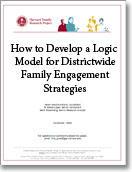The Harvard Family Research Project separated from the Harvard Graduate School of Education to become the Global Family Research Project as of January 1, 2017. It is no longer affiliated with Harvard University.

|
November 2009 How to Develop a Logic Model for Districtwide Family Engagement StrategiesHelen Westmoreland, M. Elena Lopez, Heidi Rosenberg |
Article Information
- Full Text (HTML)
- Full Text (PDF: 63 kb)
FINE: The Family Involvement Network of Educators
![]() The FINE Newsletter shares the newest and best family involvement research and resources from HFRP and other field leaders.
The FINE Newsletter shares the newest and best family involvement research and resources from HFRP and other field leaders.
FINE Newsletter, Volume I, Issue 4
Issue Topic: Family Engagement as a Shared Responsibility
Tips & Tools From Harvard Family Research Project
How to Develop a Logic Model for Districtwide Family Engagement Strategies is a step-by-step guide to help you understand and develop a logic model for districtwide family engagement efforts. It is designed to accompany Seeing is Believing: Promising Practices for How School Districts Promote Family Engagement, a policy brief created by Harvard Family Research Project and the National PTA.
This tool clarifies the steps between family engagement efforts and better learning outcomes for children and youth. In addition, you can refer to a sample logic model based on promising practices highlighted in Seeing is Believing, as well as lessons learned from research and evaluation studies that shape the outcomes of family engagement.
Benefits of creating a logic model to illustrate your district’s family engagement strategy include:
- Determining which goals are realistic, given available resources and priorities
- Creating a shared understanding of how your district plans to reach its goals, which can facilitate program planning
- Charting the progress of your work and intended outcomes, which can guide the evaluation and improvement of your strategy
- Communicating what your district wants to achieve and how it will get there, including specific areas of focus
Use this tool to learn how to:
- Understand what a logic model is and how it can help your strategic planning efforts
- Define the goals that will shape your family engagement strategy
- Identify the resources your district can access to implement your strategy
- Specify which activities your district will implement
- Define the desired outcomes of your district’s family engagement activities
- Select performance measures to track your district’s progress
This article is part of the November 2009 FINE Newsletter. The FINE Newsletter shares the newest and best family involvement research and resources from Harvard Family Research Project and other field leaders. To access the FINE Newsletter Archive, visit www.hfrp.org/FINENewsletter.
Free. Available online only.
